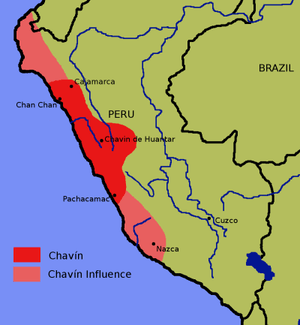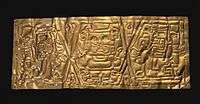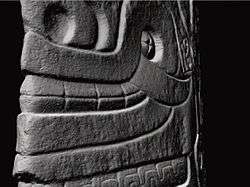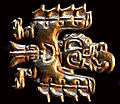Chavín culture
| Chavín culture | ||||||||
| Chavín | ||||||||
| Culture | ||||||||
| ||||||||
 The area of the Chavín culture, as well as areas the Chavín culture influenced. | ||||||||
| Capital | Chavín de Huantar | |||||||
| Political structure | Culture | |||||||
| Historical era | Pre-Columbian | |||||||
| • | Established | 900 BC | ||||||
| • | Disestablished | 250 BC | ||||||
| ||||||||
The Chavín culture is an extinct, prehistoric civilization, named for Chavín de Huantar, the principal archaeological site at which its artifacts have been found. The culture developed in the northern Andean highlands of Peru from 900 BC to 200 BC. It extended its influence to other civilizations along the coast.[1][2] The Chavín people (whose name for themselves is unknown) were located in the Mosna Valley where the Mosna and Huachecsa rivers merge. This area is 3,150 metres (10,330 ft) above sea level and encompasses the quechua, suni, and puna life zones.[3]
The best-known archaeological site for the Chavín culture is Chavín de Huantar, located in the Andean highlands of the present-day Ancash Region. It is believed to have been built around 900 BC and was the religious and political center of the Chavín people.[3] It has been designated a UNESCO World Heritage Site.
Achievements

The chief example of architecture is the Chavín de Huantar temple. The temple's design shows complex innovation to adapt to the highland environments of Peru. To avoid the temple's being flooded and destroyed during the rainy season, the Chavín people created a successful drainage system. Several canals built under the temple acted as drainage. The Chavín people also showed advanced acoustic understanding. During the rainy season water rushes through the canals and creates a roaring sound and creates a noise like a jaguar, a sacred animal. The temple was built of white granite and black limestone, neither of which is found near the Chavín site. This meant that leaders organized many workers to bring the special materials from far away rather than use local rock deposits.
The Chavín culture also demonstrated advanced skills and knowledge in metallurgy, soldering, and temperature control. They used early techniques to develop refined gold work. The melting of metal had been discovered at this point and was used as a solder.[4]
The people domesticated camelids such as llamas. Camelids were used for pack animals, for fiber, and for meat. They produced ch'arki, or llama jerky.[5] This product was commonly traded by camelid-herders and was the main economic resource for the Chavín people. Chavín people also successfully cultivated several crops, including potatoes, quinoa, and maize. They developed an irrigation system to assist the growth of these crops.[6]
Language
The language spoken by the Chavín people is not known, but it is likely now extinct.[7] Some anthropologists have proposed that it was a form of Proto-Quechuan, reasoning that the Quechuan languages' highly regular morphology and syntax compared to surrounding languages would have been useful for allowing intelligible communication between communities separated by mountain ranges, as some Chavín groups were.[8] On the other hand, Alfredo Torero dates the Proto-Quechuan languages around the beginning of the first millennium A.D.
Art


The Chavín culture represents the first widespread, recognizable artistic style in the Andes. Chavín art can be divided into two phases: The first phase corresponding to the construction of the "Old Temple" at Chavín de Huantar (c. 900–500 BC); and the second phase corresponding to the construction of Chavín de Huantar's "New Temple" (c. 500–200 BC).
A general study of the coastal Chavín pottery with respect to shape reveals two kinds of vessels: a polyhedral carved type and a globular painted type.[9] Stylistically, Chavín art forms make extensive use of the technique of contour rivalry. The art is intentionally difficult to interpret and understand, since it was intended only to be read by high priests of the Chavín cult, who could understand the intricately complex and sacred designs. The Raimondi Stele is one of the major examples of this technique.
Chavín art decorates the walls of the temple and includes carvings, sculptures and pottery. Artists depicted exotic creatures found in other regions, such as jaguars and eagles, rather than local plants and animals. The feline figure is one of the most important motifs seen in Chavín art. It has an important religious meaning and is repeated on many carvings and sculptures. Eagles are also commonly seen throughout Chavín art. There are three important artifacts which are the major examples of Chavín art. These artifacts are the Tello Obelisk, tenon heads, and the Lanzón.
Tello Obelisk is a giant sculpted shaft which features images of plants and animals. It includes caymans, birds, crops, and human figures. The large artifact may portray a creation myth. Tenon heads are found throughout Chavín de Huantar and are one of the most well-known images associated with the Chavín civilization. Tenon heads are massive stone carvings of fanged jaguar heads which project from the tops of the interior walls.
Possibly the most impressive artifact from Chavín de Huantar is the Lanzón. The Lanzón is a 4.53-meter-long carved granite shaft displayed in the temple. The shaft extends through an entire floor of the structure and the ceiling. It is carved with an image of a fanged deity, the chief cult image of the Chavín people.[10]
Sphere of influence

The Chavín culture had a wide sphere of influence throughout surrounding civilizations. For example, Pacopampa, located north (about a 3-week trek) of Chavín de Huantar, has renovations on the main temple that are characteristic of Chavín culture. Caballo Muerto, a coastal site in the Moche Valley region, has an adobe structure created during renovation of the main temple, the adobe related to Chavín influence. Garagay, a site in the modern-day Lima region, has variations of the characteristic Chavín iconography, including a head with mucus coming from the nostrils. At the site of Cerro Blanco, in the Nepena valley, excavations revealed Chavín ceramics.
Warfare does not seem to have been a significant element in Chavín culture. The archaeological evidence shows a lack of basic defensive structures in Chavín centres, and warriors are not depicted in art, in notable contrast to the earlier art at Cerro Sechín. Effective social control may have been exercised by religious pressure, and the ability to exclude dissidents from managed water resources. The climate and terrain of the neighbouring areas outside the managed land were a daunting option for farmers wishing to flee the culture.[11] Evidence of warfare has been found only in contemporaneous sites that were not influenced by Chavín culture, almost as if those other civilizations were defending themselves via warfare from Chavín cultural influence.[1]
Chavín culture as a style, and probably as a period, was widespread, stretching from Piura on the far north coast to Paracas on the south coast; and from Chavín in the north highlands to Pukara in the south highlands.[12]
Chavín horizon development

Some scholars argued that the development of Chavín social complexities coincided with the cultivation of maize and development of agricultural surpluses. Through an analysis of carbon isotope in the human bones found at Chavín sites, researchers have proved that the diet consisted mainly of C3 foods such as potatoes and quinoa, while maize, a C4 food, was not a part of the main diet. Potato and quinoa were crops better adapted to the Chavín environment. They are more resistant to the frost and irregular rain fall associated with high-altitude environments. Maize would not have been able to thrive in such conditions.[2]
Pre-Chavín levels
Kotosh Religious Tradition preceded the Chavín culture at various sites.
Some Kotosh elements show links with the Chavín culture, such as for example the ceramic styles.[13][14]
Prior to Kotosh was the Wairajirca Period. This is when the first pottery appeared.
Mito tradition was even earlier. This was a preceramic tradition. Nevertheless, public buildings were constructed.
Chavín levels
The Chavín culture archaeological horizon, itself, has three ceramic stages. They were originally identified through stratified ceramics and encompass three stages of development for the Chavín culture.
- Urabarriu, the first stage, extends from 900 to 500 BCE. During this time at Chavín de Huantar, two small residential areas, not located directly surrounding the ceremonial center, housed a few hundred people in total. This phase showed the greatest animal diversity. The people hunted mainly deer and began to hunt and use camelids. They ate clams and shellfish from the Pacific Ocean, as well as guinea pigs and birds. Chavín people grew some maize and potatoes during this phase.[5] The ceramics in the Urabarriu stage are highly influenced by other cultures.[1] The archeological evidence suggests dispersed centers of production for ceramics, probably in response to a low demand from the dispersed population.[15]
- The Chakinani, 500 to 400 BCE, is a short time of transition in Chavín culture. During this time the residents migrated to surround the ceremonial center. The Chavín began to domesticate the llama and reduced deer hunting. Evidence of increased exchange with outside civilizations is also seen at this time.[1]
- The Jarabarriu, the final stage of the Chavín Horizon, lasted from about 400 to 250 BCE. Chavín culture had a dramatic increase in population. The settlement pattern changed to a proto-urban pattern, consisting of a center of lowland valley peoples and smaller satellite communities in the surrounding higher altitude areas. The culture showed specialization and social differentiation. The people who lived in the east at Chavín de Huantar are thought to have had lower prestige than the communities around the ceremonial center.[1] A diverse and intense production of ceramics is suggested during the Jarabarriu phase, when the valley was heavily populated and the ceramic style more defined. Satellite communities also developed centers of production during this phase.[15]
Presence of elite

At Chavín, power was legitimized through the belief in the small elite having a divine connection; shamans derived power and authority from their claim to a divine connection. The community believed in and had a desire to connect with the divine. With asymmetrical power, there is often evidence of the manipulation of traditions. Strategic manipulation is a vehicle of change which shamans could use to produce authority. During the Chavín horizon, large changes were taking place.[16][17]
"The greater degree of elaboration of persuasion evident in the rites, materials, and settings of the belief system, the more likely that, not only were the leaders aware of being self-serving in their actions, but also they were actually conscious of the trajectory change." [16] The archeological evidence shows several examples of reinterpretation, use of psychotropic drugs, and landscape altering. It also shows the complex planning and construction of stone-walled galleries.[16]
The concept of invented tradition refers to a situation in which outside elements are newly brought together to depict a seemingly old tradition. This can be seen generally in the architecture at Chavín de Huantar, which bring together many aspects of outside cultures to create a unique new, yet traditional appearance.[16][17][18]
The use of psychotropic drugs introduces a medium for manipulation. Only indirect evidence supports the use of psychotropic drugs, as noted above. Scholars have not been able to determine, if the San Pedro cactus was ingested, who consumed the cactus: only the shaman elite, or more widespread among the masses. If the masses were taking the cactus, they would be more susceptible to the influences of the shamans. If the shamans were the only ones to consume it, the practice may have been sacred and a status symbol. The shamans would be perceived to have special powers to connect with the nature and the divine.[16][17]
The extensive degree of landscape altering at Chavín de Huantar for temple reconstructions shows that someone or a group of people had the power to plan the reconstructions and influence others to carry out those plans. The large constructions that occurred at this site support the hypothesis of asymmetrical power.[16][17]
Finally, the planning and construction of the stone-walled galleries, in particular, suggest a hierarchical system. In addition to the requirement to command and direct the manpower required, the galleries show unique planning. They allowed only one entrance; this is atypical of the time, when rooms commonly had multiple entrances and exits. The iconography on the walls of the stone galleries is highly complex. The complexity suggests that only a select few people were able to understand the iconography; such people would serve as translators for the few others who were privileged to view the stone galleries. The limited access, both physically and symbolically, of the stone-walled galleries supports the existence of a shaman elite at Chavín de Huantar. The evolution of authority at Chavín appears to have resulted from a planned strategy by the shamans and those who planned and constructed the ceremonial center.[16]

Gallery
 The sandeel monolithic has a length of 5 meters and represents a Chavín deity. It is located in theAncient Temple in Chavín de Huantar.
The sandeel monolithic has a length of 5 meters and represents a Chavín deity. It is located in theAncient Temple in Chavín de Huantar. Gold Chavín. Larco Museum, Lima
Gold Chavín. Larco Museum, Lima Gold Chavín
Gold Chavín- Chavín Gold Necklace
- Condor head, at the National Museum of Chavín de Huantar.
- Chavin nailed head
- The tusks are present in all the arts of Chavín including in the sculpture as this nails head.
- Nails head embedded in one of the walls of the temple of Chavín de Huantar.
 Stela Chavín. National Museum Chavín de Huantar.
Stela Chavín. National Museum Chavín de Huantar. There are many Chavínes trails representing mythological creatures like this.
There are many Chavínes trails representing mythological creatures like this. Stela Chavín with image of an ornithological.
Stela Chavín with image of an ornithological. Chavín stela depicting a brindle face. National Museum Chavín de Huantar.
Chavín stela depicting a brindle face. National Museum Chavín de Huantar. The ceremonial centre of Kuntur Wasi, according to the latest archaeological research would be an prechavín expression associated to felínico Chavín cult. Cajamarca Region.
The ceremonial centre of Kuntur Wasi, according to the latest archaeological research would be an prechavín expression associated to felínico Chavín cult. Cajamarca Region. Remains of Pacopampa, another prechavín expression of Formative stage period but remained an important ceremonial centre like Chavín de Huantar, also located in the Cajamarca Region.
Remains of Pacopampa, another prechavín expression of Formative stage period but remained an important ceremonial centre like Chavín de Huantar, also located in the Cajamarca Region. Model of the archaeological site of Chavín de Huantar.
Model of the archaeological site of Chavín de Huantar. The llama was the main representative of Chavín livestock.
The llama was the main representative of Chavín livestock.
See also
| Wikimedia Commons has media related to Chavin culture. |
Notes
- 1 2 3 4 5 Burger, Richard L. 2008 "Chavin de Huantar and its Sphere of Influence", In Handbook of South American Archeology, edited by H. Silverman and W. Isbell. New York: Springer, pp. 681–706
- 1 2 Burger, Richard L., and Nikolaas J. Van Der Merwe (1990). "Maize and the Origin of Highland Chavín Civilization: An Isotopic Perspective", American Anthropologist 92(1):85–95.
- 1 2 Burger (1992), Chavin and the Origins of Andean Civilization
- ↑ Lothrop, S. K. (1951) "Gold Artifacts of Chavin Style", American Antiquity 16(3):226–240
- 1 2 Miller and Burger, 1995
- ↑ Burger and Van Der Merwe, 1990
- ↑ Wolfson, Nessa; Manes, Joan. Language of Inequality. p. 186.
- ↑ Campbell, Lyle; Grondona, Verónica. The Indigenous Languages of South America: A Comprehensive Guide. p. 588.
- ↑ Tello, Julio C. (1943) "Discovery of the Chavín Culture in Peru", American Antiquity 9(1, Countries South of the Rio Grande):135–160.
- ↑ Burger, Richard L. Chavin and the Origins of Andean Civilization. New York: Thames and Hudson, 1992.
- ↑ Burger (1992), pp. 78-79, 225, 65, 78
- ↑ Bennett, Wendell C. (1943) "The Position of Chavin in Andean Sequences", Proceedings of the American Philosophical Society 86(2, Symposium on Recent Advances in American Archeology):323–327.
- ↑ Izumi and Sono, 1963, p. 155
- ↑ Seiichi IZUMI, Pedro J. CUCULIZA, Chiaki KANO, INTRODUCTION, Bulletin No.3: EXCAVATIONS AT SHILLACOTO, HUANUCO, PERU. The University Museum, University of Tokyo, 1972
- 1 2 Druc, Isabelle C. 2004 "Ceramic Diversity in Chavín De Huantar, Peru", Latin American Antiquity 15(3):344–363.
- ↑ Burger, Richard (1992) "Sacred Center at Chavin de Huantar", In The Ancient Americas: Art from Sacred Landscapes, Chicago: Art Institute of Chicago, and Museum of Fine Arts, Houston.
References
- Bennett, Wendell C. (1943) "The Position of Chavin in Andean Sequences", Proceedings of the American Philosophical Society 86(2, Symposium on Recent Advances in American Archeology), [323–327].
- Burger, Richard L. and Nikolaas J. Van Der Merwe. "Maize and the Origin of Highland Chavin Civilization: An Isotopic Perspective", American Anthropologist 92, 1 (1990), [85–95].
- Burger, Richard L. 1992 Chavin and the Origins of Andean Civilization. New York: Thames and Hudson.
- Burger, Richard L. 1992 "Sacred Center at Chavin de Huantar". In The Ancient Americas: Art from Sacred Landscapes. Chicago: Art Institute of Chicago. Art Institute of Chicago, and Museum of Fine Arts, Houston.
- Burger, Richard L. 2008 "Chavin de Huantar and its Sphere of Influence", In Handbook of South American Archeology, edited by H. Silverman and W. Isbell. Springer, New York, [681–706].
- Druc, Isabelle C. 2004 "Ceramic Diversity in Chavín De Huantar, Peru". Latin American Antiquity 15(3), [344–363].
- Kanåo, Chiaki. 1979 The Origins of the Chavin Culture. Washington, D.C: Dumbarton Oaks, Trustees for Harvard University.
- Kembel, Silvia Rodriquez and John W. Rick. 2004 Building Authority at Chavin de Huantar: Models of Social Organization and Development in the Initial Period and Early Horizon. In Andean Archaeology. Malden, Massachusetts: Blackwell Publishing.
- Lothrop, S. K. "Gold Artifacts of Chavin Style" Society for American Anthropology 16, 3 (1951), [226–240].
- Mann, Charles C. (July 2011). "Writing, Wheels, and Bucket Brigades". 1491: New Revelations of the Americas Before Columbus (2nd ed.). New York: Vintage Books. pp. 273–274. ISBN 978-1-4000-3205-1.
- Miller, George R. and Richard L. Burger. "Our Father the Cayman, Our Dinner the Llama: Animal Utilization at Chavin de Huantar, Peru", American Antiquity 60, 3 (1995). [421–458]
- Tello, Julio C. "Discovery of the Chavin Culture in Peru", American Antiquity 9, 1 (1943), [135–160], As you can see the Chavin influenced many other civilizations!
- Enter The Jaguar Mike Jay 2005.
External links
- http://www.ancient.eu/Chavin_Civilization Ancient History Encyclopedia
| Library resources about Chavín culture |
- (Spanish) Peru Cultural website
- Minnesota State University e-museum
- Chavín de Huantar Digital Media Archive (Creative Commons-licensed photos, laser scans, panoramas), data from a Stanford University/CyArk research partnership (see Exploring Chavín de Huantar link above for additional contextual information)
- Chavín Project with a bibliography and external links
- Chavín Culture